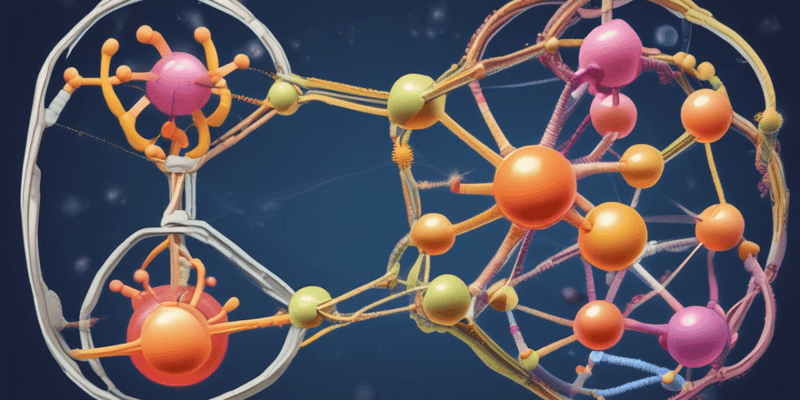15 Questions
What are the three components of a nucleotide?
A nitrogenous base, a pentose monosaccharide, and one, two, or three phosphate groups
What is the difference between thymine (T) and uracil (U)?
T has a methyl group, while U does not
What is the product of adding a pentose sugar to a base through an N-glycosidic bond?
A nucleoside
What is the sugar component of DNA?
2-Deoxyribose
What is the term for the addition of a phosphate group to a nucleoside?
Phosphorylation
Which of the following is NOT a type of base found in DNA?
Uracil
What is the term for the degradation of bases?
Nuclease activity
What is the primary function of nucleotides in RNA and DNA synthesis?
To serve as building blocks of RNA and DNA
Which of the following nucleotides is not a second messenger in signal transduction pathways?
UDP-glucose
What is the role of nucleotides in the synthesis of some carbohydrates, lipids, and conjugated proteins?
They are carriers of activated intermediates
Which of the following is a purine base found in nucleotides?
Adenine
What is the role of nucleotides in intermediary metabolism?
They inhibit or activate key enzymes
Which of the following coenzymes is not a structural component of nucleotides?
ATP
What is the purpose of salvage pathways in nucleotide metabolism?
To allow the reuse of preformed bases
Which of the following is NOT a physiological importance of nucleotides?
They are involved in the synthesis of antibodies
Study Notes
Structure of Nucleotides
- Nucleotides are composed of a nitrogenous base, a pentose monosaccharide, and one, two, or three phosphate groups.
Purine and Pyrimidine Bases
- Purine bases in DNA and RNA: adenine (A) and guanine (G).
- Pyrimidine bases in DNA and RNA: cytosine (C) and thymine (T) in DNA, uracil (U) in RNA.
- Thymine (T) has a methyl group, which is not present in uracil (U).
Nucleosides
- A nucleoside is formed by the addition of a pentose sugar to a base through an N-glycosidic bond.
- Ribonucleosides: adenosine, guanosine, cytidine, and uridine.
- Deoxyribonucleosides: deoxyadenosine, deoxyguanosine, deoxycytidine, and deoxythymidine (thymidine).
Nucleotides
- A nucleotide is formed by the addition of one or more phosphate groups to a nucleoside.
- The first phosphate group is attached to the 5′-OH of the pentose, forming a nucleoside 5′-phosphate or a 5′-nucleotide.
Physiological Importance of Nucleotides
- Nucleotides are essential for all cells and serve as building blocks of RNA and DNA.
- Nucleotides are required for protein synthesis and cell proliferation.
- Nucleotides serve as carriers of activated intermediates in the synthesis of some carbohydrates, lipids, and conjugated proteins.
- Nucleotides are structural components of several essential coenzymes, including Co-A, FADH2, NADH, and NADPH.
- Nucleotides serve as second messengers in signal transduction pathways, such as cAMP and cGMP.
- Nucleotides play an important role as energy sources in the cell, with ATP being a key example.
- Nucleotides are important regulatory compounds for many of the pathways of intermediary metabolism.
This quiz covers the composition of nucleotides, including nitrogenous bases, pentose monosaccharide, and phosphate groups. It also explores the different types of purine and pyrimidine bases found in DNA and RNA.
Make Your Own Quizzes and Flashcards
Convert your notes into interactive study material.
Get started for free


